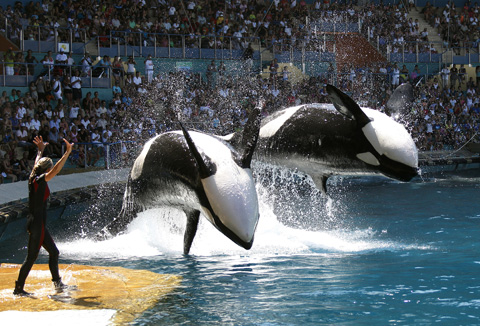
A MARINE CIRCUS The treatment of these spectacular animals is the centerpiece of Blackfish.
It’s too bad SeaWorld wouldn’t tell its side of the story. |
The kind of documentary where a transition to a Spanish island is accompanied by a burst of scenery and a fleeting flourish of Spanish guitar, Gabriela Cowperthwaite’s unimaginative Blackfish has just enough gripping footage to make up for its unrelenting structural blandness.
Cowperthwaite’s film also benefits from clearly being in the right: it sets out to expose SeaWorld’s unnatural, immoral practices of orca capture and captivity, and more intriguingly attempts to build a case against the company’s treatment of its whale and dolphin trainers. Most of
Cowperthwaite’s talking heads are former SeaWorld trainers, whose job — to a considerable degree — consisted simply of building trusting and amiable relationships with the multi-ton mammals the company’s name is associated with. Blackfish not only reveals what happens when those relationships go briefly, sometimes fatally wrong; it also exposes SeaWorld’s dispiriting responses to these incidents.
Blackfish establishes SeaWorld’s disturbing tactics of orca capture rather quickly, with video filmed in Puget Sound of killer whale families being broken up as fishermen seek the young who might go on to be trained to become performers in Orlando and San Diego. The footage is bleak: three whales die in the episode, and SeaWorld shifts its capture activities to Iceland after national outrage. The scene speaks volumes, but Blackfish then spends a great deal of time with a killer whale expert who makes the already apparent point that these violent ruptures of family units make an indelible impact on an orca’s psychology, repeatedly emphasizing that these are social animals that are also tribal, and not meant to cohabitate among whales from other families. The viewer can mentally envision the DVD chapters progressing as
Cowperthwaite repeatedly breaks away from her investigation to five-minute interludes celebrating the kindness and brilliance of orcas in their natural habitat.
What makes these episodes especially frustrating are the muddier, underexplored aspects of her argument against SeaWorld. Blackfish always has righteousness and evidence on its side, but the film’s case against the company feels scattershot rather than cumulative. The most successful thread of this argument is the story of Tilikum, an especially large orca with a history of violent behavior whom SeaWorld purchases from a small, shady Canadian outfit. SeaWorld makes the whale a star — thanks to its size and in disregard of a series of alternately sketchy and gruesome incidents, including a notorious night in which Tilikum killed a trespasser later labeled an irresponsible, homeless “drifter.” (Despite a wealth of surveillance cameras on the premises, SeaWorld claims no video of the event exists.) With the aid of her talking heads, Cowperthwaite reveals the company’s major financial interest in keeping a plainly violent animal: Tilikum’s sperm is worth a tremendous amount of money, and SeaWorld uses it to breed new generations of orcas despite his instability.